by Michael Cropper | Oct 24, 2015 | Digital Strategy |
We see a lot of WordPress websites as you can imagine with WordPress development being a core service we offer. Within these WordPress websites we see an awful lot of baggage which is limiting the growth of the website and is often caused by poor technology decisions earlier on. This post is designed to help you understand what the common issues we see are, what they mean in non-technical terms and most importantly what you can do to avoid these same problems in the future.
If you have been sent this link from a member of staff, then the likelihood is that you have unfortunately made the wrong technology decisions on your website 1-2 years ago which is now coming back to bite and it’s unfortunate that the only way of dealing with this is to bite the bullet and implement the right technology which comes at a cost. Instead of us keep explaining the variety of reasons why something cannot be implemented effectively on a website, we’ve decided to put together this guide to outline this information in more depth which can be referred to by everyone and to hopefully avoid others making the same mistakes as we see so many businesses make.
About WordPress
Ok, so you’ve decided to use WordPress for your website. Awesome! WordPress is a great choice for many businesses and is the leading content management system on the planet, powering over 23% of websites on the entire internet. There are over 30,000 free plugins available, thousands of themes and even more “WordPress Developers” who claim to be able to implement all of these things well. There are many free options and a smaller number of paid options for all of the above and herein lies the problem. The theory VS the reality are rather different and have significant implications for your business in the short, medium and long term. Here are a few common comments we often hear from businesses, again to avoid repeating ourselves on the matter, let’s just cover off a few things straight away;
“WordPress, it’s free right? So why does this cost money to do?”
Hmm. Yes, WordPress core functionality is indeed free and if you want your website to look like it was free then you are more than welcome to give this a go yourself. I’m going to tell you a little story here about a boiler person fixing a problem to highlight what you are paying for.
So you are sitting at home all cosy and all of a sudden your boiler stops working. You go to the boiler, try and re-pressure the boiler, tap on the dials a bit, press a few buttons and then you are still no wiser as to what has happened or how to fix the problem. So you decide to call out a boiler engineer. The next day the boiler engineer comes around to your house where you then explain the problem to them and it is a common problem they have dealt with many times before. By the time you have offered to make them a cup of tea, they have given the boiler a couple of taps and everything is back to normal again. They hand you an invoice for £150 for fixing the problem and just before they leave you have a question running around in your mind and decide to speak up. You say, why has this cost me £150, you’ve only been here 5 minutes? Ah, the boiler person says, it is not the time you are paying for, it is the expertise to be able to fix this problem within this small amount of time. It’s about knowing exactly where to tap on the boiler when this problem occurs. You see, you could quite happily have spent days searching around the internet trying to solve the problem for yourself or had a junior boiler engineer come around and fix the problem over 6 hours, but with me, with me you get many years of experience and vast expertise so that this problem can indeed be fixed in as little as 5 minutes. You see, anything is simple when you have the experience and knowledge to do so. The trick is, acquiring this knowledge and experience over a number of years takes a dedicated amount of time and effort.
Website development is no different.
“Why do I have to purchase this plugin, can’t you just build this yourself instead?”
Premium plugins and themes are awesome and you need to understand that this is the way the WordPress ecosystem works. It is the reason WordPress websites are so cost effective in comparison to building your own custom build technology. The difference between buying a premium plugin VS building this functionality yourself is the same difference between buying a high performance car from a showroom VS building your own car from the raw materials. You just aren’t going to do that are you now? For the cost of premium plugins, you would never even contemplate building your own functionality if you can simply purchase this and it does exactly what you need as it would cost 10-50x more to do this manually from scratch due to how complex WordPress actually is in the background to get things working correctly.
“Why do I need to pay annually for a licence for a plugin or theme?”
You want your website to be up to date and secure, right? This is what you are paying for. Premium plugin and theme developers continually keep their technology up to date, add features and functionality along with patching security holes that have been identified. When you decide to save a few pennies on your technologies, you will be bitten in no time when your website is hacked into by an automated robot. We’ve seen this happen too many times and we will quite happily help to clean this up for you when this does happen which will cost you more in the long run.
Child Themes
This has to be one of the biggest issues we see for businesses. To keep things simple and straight forward, you must use a child theme if you are making any customisations to your theme! It really is this simple.
Ok, so what is a child theme? A child theme a way of customising your WordPress website, generally by the developer who built it, whereby you can override key functionality in a safe way. As mentioned previously, security updates and feature addons to themes come out all the time, so it is important to keep these up to date. If you edit your theme directly, when you press the friendly looking “update” button, you will be left with a shocking surprise when all of your customisations have been deleted. Again, we’ve seen this happen time and time again.
What this means for business owners is that you need to check that your WordPress website is being built by a reputable developer in the first place and also that they are going to be using a child theme for any customisations that are made. If not, then when someone else takes this on, such as our self, there can be no guarantees that a theme update will not cause any issues. A simple theme update could actually cause days if not weeks worth of work to fix critical problems just to get your website looking how it was looking previously.
What often happens is that when businesses come to us, we explain that a website hasn’t been built using a child theme, that we cannot guarantee no issues and really they are going to need to redevelop the website. Which often is a little confusing to hear as they only wanted a few simple changes to be made. The reason why this is required is because if we press the nice little “update” button and cannot guarantee that updates will no break anything, then we will be left with the situation of having to clean up the mess from other developers which we are not willing to do and is something that often you would not be willing to pay for as you would see the situation that we have broken it. When in fact, the problem lies with the poor technology choices you made previously.
If your website has not been customised with a child theme, the short answer is always going to be that you need to get this redeveloped properly. Unless you are 100% confident that you or your previous web developer has not made any changes to the core theme files and that you are willing to pay extra for when things break and have to be cleaned up, then the only option is to rebuild your website. Out of experience, the simplest and most cost effective solution is to just do the right thing and get the right technology in place.
Theme Market Place Themes
This nicely brings us onto how many websites end up in this situation. Generally speaking, experienced WordPress developers do not purchase their themes from theme market places because they are often utter garbage when it comes to how they have been built, how they are maintained and most importantly how difficult they are to use from a development point and also for users. Often we find that when businesses come to us with WordPress related problem that they are struggling to make the changes that they want to the website, this is often down to either their self or their last web developer who has decided to purchase a $60 bargain basement theme from one of the theme market places because it looked pretty.
Sadly, we’ve yet to experience a good result when businesses have gone down this route. If this relates to you, do not be offended when we refuse to work with your current theme and can only help when rebuilding your website with leading technology.
We often find with themes that have been purchased from theme market places is that the theme will be bundled with a bunch of plugins, aka additional functionality, which is never a good solution. As mentioned previously, themes and plugins are being continually updated with new features and security patches. You tend to find when you purchase themes from theme market places that these themes aren’t that up to date and often when a security patch is announced then the theme author doesn’t update the theme which results in your website being vulnerable and open to being hacked.
Quite simply, plugins should not be bundled into themes. Plugins should be stand alone separate systems which users have the option of updating separately and most importantly turning on/off the functionality as they need. If you are in a situation whereby your theme has multiple plugins bundled into it, be very wary and you’re probably going to hear those words from us very soon… You’re going to need a new website.
Lack of Security Updates
We’re going to be covering this topic in much more detail in another blog post. For now though, let’s keep things simple. As WordPress powers over 23% of websites on the internet, it is naturally a target for attackers. These are often not targeted attacks but are vulnerability attacks. This means that a robot will run through all websites on the internet, identify what version of WordPress a website is running, what plugins and themes the website is running then most importantly check for known vulnerabilities for these websites and hack into them, fully automated.
Some of the largest causes of hacked WordPress websites comes down to lack of security updates. This is in the form of theme updates, plugin updates and WordPress core updates – or lack of all of these. Quite simply, you need to keep your entire WordPress website up to date to avoid being hacked into. The choice is yours.
Can’t Edit the Content Yourself
We often hear;
“Isn’t WordPress supposed to allow you to edit everything yourself?”
Well, yes, in theory. The reality of this can be very different based on how your WordPress website has been put together and most importantly what technology has been used and how good the web developer you used was.
The reality of many websites we see is that things are so difficult to edit from a novice user point of view that this results in all changes needing to be made by an expert or a web developer which is kind of missing the point of WordPress.
We see content stuffed into sections of WordPress which were never designed to hold such content, we see content that is stuffed away in PHP files which users cannot edit their self, and we see content hidden away in a complex array of plugins and hidden settings and more. Most WordPress websites have been built without the user in mind which we just cannot understand. From our perspective, we do not want to be spending time editing text content on your website. This is not a good use of your budget and quite frankly this is something you should be doing yourself, it is your website and your business. We can work on the more cool pieces of functionality and integrations that is going to grow your business.
Quite simply, if you are struggling to edit content on your WordPress website then it has probably been built extremely badly. So don’t be surprised if you soon hear us utter the words… You’re going to need a new website. As it will be much more cost effective in the long run when you can run your website as you need to.
Access Restrictions & Owning Your Own WordPress Website
We still see so many issues related to ownership of your own website. You need to have access to your WordPress login area as an Administrator, you need to have FTP access to the web server where your website lives, you need to have control panel access for your web server. To keep things simple, you need to be using our free Digital Assets Tracker to keep track of who owns what and who has access to what.
Could You Just…
Ahh… one of the common starts of sentences which really translates to “I don’t want to pay you for this, so could you just do this for free?” Sorry, no. You wouldn’t ask a car mechanic after fitting a new tyre, “Could you just wash my car too?” Website development is no different. What you may see as a simple thing to do, often actually isn’t and requires a reasonable amount of time and customisation to get right. You need to understand the time involved in aspects of work, so don’t be offended when we can’t just tweak something for free. We can quite happily provide a quote for the work and you can then make the decision to either go ahead with this work or not, this is your website after all.
Responsive
We often hear comments along the lines of;
“Can’t you just make the current website responsive?”
I’m sorry, WordPress just doesn’t work like that. The theory of WordPress means that you should just be able to place a new theme on your WordPress installation and everything looks different. The reality is hugely different. If your website isn’t responsive currently, then quite simply you are just going to need a new website built to cope with this.
Responsive web design is a whole topic in itself which we will be covering in more detail in a future blog post. What is important to understand though is that the basics of responsive web design mean that you have the same content accessible which is just presented in a slightly different way. Note the use of the word slightly here. Responsive web design is not a framework for showing users different content based on the device they are using, that is adaptive web design. Responsive web design is about re-jigging things a little based on the user’s device which is significantly different. For example, responsive web design just doesn’t work when you want things such as “I don’t want this section to display for users on mobile devices”. The technology simply isn’t designed for this, so again, don’t be disgruntled when we say that this cannot be done.
Summary
Overall this blog post is not designed to be a moan about problems we see. No. Instead this blog post is designed to help you understand where we are coming from when we say different things during discussions. Most importantly though, by understand the concepts above and how this relates to yourself, this will hopefully help you to avoid making the same mistakes as others and also be able to plan for the right technology improvements that you are going to need within your business.
by Michael Cropper | Oct 22, 2015 | SEO |
Well, what an awesome day WordCamp Manchester 2015 was! With over 150 attendees, digital experts travelling from as far away as Brighton and gallons of coffee drunk. The conference was a roaring success with many people commenting on the day about how well-organised the event was and how valuable the content from all the speakers was. All of this wouldn’t have been possible without the team of volunteers behind the scenes organising the conference over the last 6 months, it was great to be involved with this. And let’s not forget the wonderful sponsors who financially made this happen, WordCamp Manchester 2015 wouldn’t have been such a success without the support from sponsors.
Photos
We all love a good photo or two!
Tracking your Content Marketing Results Accurately
I was presenting at the conference about how businesses can track their content marketing results accurately. While the video presentations are being collated and edited together to appear on WordPress.tv, here are the sliders for reference;
Summary
Awesome day! Same time again next year? 🙂
by Michael Cropper | Oct 8, 2015 | Digital Marketing, Social Media, Tracking |
Many small to medium sized business are afraid of social media, are unsure what they should be doing on social media and spend an awful lot of time managing social media without any idea of what they are getting back from it. We’ve already covered how to monitor your social media activities and reviewed various tools to help you manage social media effectively. Now it’s time to take this one huge step further to automate virtually 99% of your social media accounts using technology.
If you’re a business owner or aren’t that tech-savvy then some of this may be a bit over your head, so get in touch and we can look to set up the same process for you with ease and show you how to use this system. The investment in this setup using free technologies will pay for itself within a matter of weeks within your business in time saved, allowing you to spend time improving other systems and processes to become more profitable.
Before people start jumping on the bandwagon about how social media should be personal, you should spend time crafting messages and treating every account differently etc. Bear with me. The reality for many businesses is that they quite simply don’t have time to be doing the work that large brands do as large brands have teams of people managing their social media activities in the background. The reality for the majority of small to medium sized businesses is that this is left to either a single marketing manager, a junior member of the marketing team or even the managing director to manage. For all of these people, social media management is not at the top of their priority list and is an area which can be made extremely efficient with technology and automation without compromising on the quality. On the other hand, if you feel that your business needs someone to be doing everything manually, then good on you, you’re probably wasting a lot of time as this is the equivalent of still using a dustpan and brush when you could just use a Dyson or a Roomba.
Now, on to the good stuff. Personally we use a whole host of technologies, automation techniques and manual interactions to manage our social media channels which works for us. Every business is different, so take what you will from this and if this could work for you, then great, you’ll be saving hours or time per week through the use of smart technologies.
The Manual Process
Before we jump into the automation, let’s just look at the common ways people identify content to share on social media channels. They are likely subscribed to either a daily, weekly or monthly newsletter from a variety of industry magazines and websites or they use a well-crafted set of followers on social media to manage their news feed effectively. We use a mixture of both, with the main @ContradoDigital Twitter account following relevant digital accounts that share some awesome news about the world of digital. As always, not everything is relevant for what our audience wants, so we need to filter out this so that the content that is shared is highly relevant to our audience who is interested in technology, innovation, digital marketing, security and general digital news.
Based on this, we review the content that is being published around the web and any content that is relevant we also share on our social channels, both company channels and my personal channels for Twitter, LinkedIn, Facebook and Google+. We already have technology in place to automate the majority of the social media management process which saves an enormous amount of time already but we wanted to go further and really push the boundaries of what is possible.
We use Buffer to add social media updates to our queue of scheduled posts to be posted out to all social media channels along with Bitly to track the engagement from our followers to understand what content they like to read about. The last piece of the puzzle is how to automate adding content to Buffer with ease. Traditionally we would either favourite a news story on Twitter or open that news story in the browser then use the Buffer Google Chrome plugin or Buffer App on mobile to add this to the queue. While not particularly difficult to do, adding a new story to the queue could take up to 2 minutes by the time the pages have loaded and everything has been completed. 2 minutes, multiplied by 6 posts per channel per day, multiplied by 20 days per month equates to around 4 hrs per month spending time adding content to social media channels for our audience. I’d guess that this is already significantly less than what you spend managing social media channels, but we wanted to go one step further and significantly reduce this to only 60 seconds per day.
What if there was a better way…
Introducing Automation using IFTTT
If you haven’t come across If This Then That (IFTTT) before, then quite simply this piece of free technology is designed to automate almost anything you can imagine that you are doing manually. The service links together web based technologies through the use of Application Programming Interfaces (APIs) which can be simplified as systems talking to other systems.
All modern and scalable web platforms have some kind of open API built in with them as they understand how this key functionality automates the work and grows their business. It is this what we’re plugging into to join the dots and save 4 hrs per month.
The logic behind the automation is as follows;
- When a Tweet is Favorited on Twitter
- Send this to Buffer to be automatically posted out to our followers who are interested in this content
There is a little more behind the scenes which we’ll talk through in a minute, but that is the gist of the setup.
The Process for Automating 99% of Social Media Management
So let’s just jump right into how to get this set up. Once set up, you will be saving hours of time per week managing your social media activities. Most businesses spend an hr or two per day managing social media activities. We spend 60 seconds per day as we’ve implemented the right technology to become more efficient.
Bitly
Set up a Bitly.com account if you don’t have one already. This is going to track how many people are clicking on the links that you are sharing on social media on a daily, weekly and monthly basis. Allowing you to improve performance of your social media activities over time.

Buffer
Set up a Buffer.com account if you don’t have one already. This is going to automate all of your social media posts by adding everything to a pre-scheduled queue. Allowing you to simply add a post to Buffer which will then be automatically posted to your default social media profiles that you can configure to send out an update at a set time of day/week as you choose.

Make sure you link your Buffer account with Bitly in the settings to track link clicking statistics through Bitly as we find this provides a bit more insight than Buffer. You also need to set your default social media profiles up. So if you have multiple social media profiles to manage, then set which are your default ones that you want to send updates to as these will be used with this automation setup.
Buffer has the ability to email updates to Buffer which will be automatically added to your queue which is what we’re going to be using to automate things. Find your Buffer Secret Email Address within your account settings;
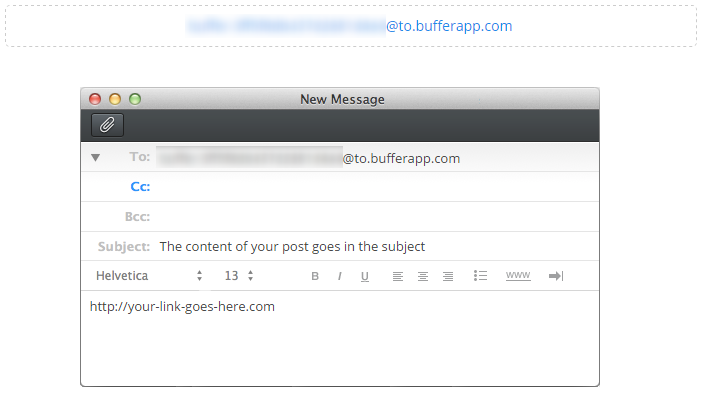
Now comes the clever part, using IFTTT.
IFTTT
Set up an IFTTT account if you don’t already have one. A component of IFTTT is that you create a Recipe which has Ingredients. Using this setup, you are essentially triggering an action to happen when something else happens beforehand.
In this example, we want to send an email to Buffer from Gmail when we Favourite a new Tweet on the @ContradoDigital Twitter account.

To do this, click on the “Create Recipe” button which will guide you through the process. As part of this process, IFTTT will connect with your Twitter account and your Gmail account. All fairly straight forward here. The part that you need to configure properly is what to contain in the email as there are specific shortcodes called Ingredients which need to be included so the correct information is sent over to Buffer to add everything to the right areas. Here you enter in your Buffer Secret Email Address from earlier along with the shortcode {{TEXT}} which will pull in the text from the Tweet you have just favorited and send this to buffer to use in the update;
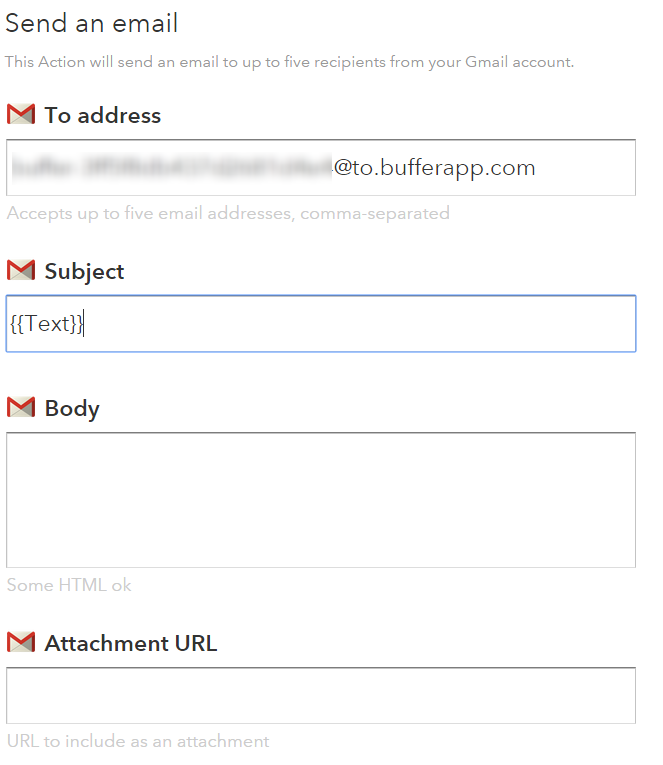
Once you’ve done this, it’s simple. Save the Recipe and start adding Tweets to your Favourites. IFTTT runs every 15 minutes or so, fully automated, so when it detects a new Tweet that you have starred then it will automatically post this out to Buffer.
All in all, meaning that we spend an average of 60 seconds per day managing our social media accounts, saving hours per month, allowing us to focus on more productive areas working with clients to implement similar technologies within their businesses to save them time and money.
If you’d like to make your social media accounts extremely efficient like we have and all of this has gone a bit over your head, then get in touch and we can look to set up the same process for you with ease. The investment in this setup using free technologies will pay for itself within a matter of weeks within your business, allowing you to spend time improving other systems and processes to become more profitable.
by Michael Cropper | Oct 8, 2015 | Uncategorized @en-us |
Many small to medium sized business are afraid of social media, are unsure what they should be doing on social media and spend an awful lot of time managing social media without any idea of what they are getting back from it. We’ve already covered how to monitor your social media activities and reviewed various tools to help you manage social media effectively. Now it’s time to take this one huge step further to automate virtually 99% of your social media accounts using technology.
If you’re a business owner or aren’t that tech-savvy then some of this may be a bit over your head, so get in touch and we can look to set up the same process for you with ease and show you how to use this system. The investment in this setup using free technologies will pay for itself within a matter of weeks within your business in time saved, allowing you to spend time improving other systems and processes to become more profitable.
Before people start jumping on the bandwagon about how social media should be personal, you should spend time crafting messages and treating every account differently etc. Bear with me. The reality for many businesses is that they quite simply don’t have time to be doing the work that large brands do as large brands have teams of people managing their social media activities in the background. The reality for the majority of small to medium sized businesses is that this is left to either a single marketing manager, a junior member of the marketing team or even the managing director to manage. For all of these people, social media management is not at the top of their priority list and is an area which can be made extremely efficient with technology and automation without compromising on the quality. On the other hand, if you feel that your business needs someone to be doing everything manually, then good on you, you’re probably wasting a lot of time as this is the equivalent of still using a dustpan and brush when you could just use a Dyson or a Roomba.
Now, on to the good stuff. Personally we use a whole host of technologies, automation techniques and manual interactions to manage our social media channels which works for us. Every business is different, so take what you will from this and if this could work for you, then great, you’ll be saving hours or time per week through the use of smart technologies.
The Manual Process
Before we jump into the automation, let’s just look at the common ways people identify content to share on social media channels. They are likely subscribed to either a daily, weekly or monthly newsletter from a variety of industry magazines and websites or they use a well-crafted set of followers on social media to manage their news feed effectively. We use a mixture of both, with the main @ContradoDigital Twitter account following relevant digital accounts that share some awesome news about the world of digital. As always, not everything is relevant for what our audience wants, so we need to filter out this so that the content that is shared is highly relevant to our audience who is interested in technology, innovation, digital marketing, security and general digital news.
Based on this, we review the content that is being published around the web and any content that is relevant we also share on our social channels, both company channels and my personal channels for Twitter, LinkedIn, Facebook and Google+. We already have technology in place to automate the majority of the social media management process which saves an enormous amount of time already but we wanted to go further and really push the boundaries of what is possible.
We use Buffer to add social media updates to our queue of scheduled posts to be posted out to all social media channels along with Bitly to track the engagement from our followers to understand what content they like to read about. The last piece of the puzzle is how to automate adding content to Buffer with ease. Traditionally we would either favourite a news story on Twitter or open that news story in the browser then use the Buffer Google Chrome plugin or Buffer App on mobile to add this to the queue. While not particularly difficult to do, adding a new story to the queue could take up to 2 minutes by the time the pages have loaded and everything has been completed. 2 minutes, multiplied by 6 posts per channel per day, multiplied by 20 days per month equates to around 4 hrs per month spending time adding content to social media channels for our audience. I’d guess that this is already significantly less than what you spend managing social media channels, but we wanted to go one step further and significantly reduce this to only 60 seconds per day.
What if there was a better way…
Introducing Automation using IFTTT
If you haven’t come across If This Then That (IFTTT) before, then quite simply this piece of free technology is designed to automate almost anything you can imagine that you are doing manually. The service links together web based technologies through the use of Application Programming Interfaces (APIs) which can be simplified as systems talking to other systems.
All modern and scalable web platforms have some kind of open API built in with them as they understand how this key functionality automates the work and grows their business. It is this what we’re plugging into to join the dots and save 4 hrs per month.
The logic behind the automation is as follows;
- When a Tweet is Favorited on Twitter
- Send this to Buffer to be automatically posted out to our followers who are interested in this content
There is a little more behind the scenes which we’ll talk through in a minute, but that is the gist of the setup.
The Process for Automating 99% of Social Media Management
So let’s just jump right into how to get this set up. Once set up, you will be saving hours of time per week managing your social media activities. Most businesses spend an hr or two per day managing social media activities. We spend 60 seconds per day as we’ve implemented the right technology to become more efficient.
Bitly
Set up a Bitly.com account if you don’t have one already. This is going to track how many people are clicking on the links that you are sharing on social media on a daily, weekly and monthly basis. Allowing you to improve performance of your social media activities over time.

Buffer
Set up a Buffer.com account if you don’t have one already. This is going to automate all of your social media posts by adding everything to a pre-scheduled queue. Allowing you to simply add a post to Buffer which will then be automatically posted to your default social media profiles that you can configure to send out an update at a set time of day/week as you choose.

Make sure you link your Buffer account with Bitly in the settings to track link clicking statistics through Bitly as we find this provides a bit more insight than Buffer. You also need to set your default social media profiles up. So if you have multiple social media profiles to manage, then set which are your default ones that you want to send updates to as these will be used with this automation setup.
Buffer has the ability to email updates to Buffer which will be automatically added to your queue which is what we’re going to be using to automate things. Find your Buffer Secret Email Address within your account settings;

Now comes the clever part, using IFTTT.
IFTTT
Set up an IFTTT account if you don’t already have one. A component of IFTTT is that you create a Recipe which has Ingredients. Using this setup, you are essentially triggering an action to happen when something else happens beforehand.
In this example, we want to send an email to Buffer from Gmail when we Favourite a new Tweet on the @ContradoDigital Twitter account.

To do this, click on the “Create Recipe” button which will guide you through the process. As part of this process, IFTTT will connect with your Twitter account and your Gmail account. All fairly straight forward here. The part that you need to configure properly is what to contain in the email as there are specific shortcodes called Ingredients which need to be included so the correct information is sent over to Buffer to add everything to the right areas. Here you enter in your Buffer Secret Email Address from earlier along with the shortcode {{TEXT}} which will pull in the text from the Tweet you have just favorited and send this to buffer to use in the update;

Once you’ve done this, it’s simple. Save the Recipe and start adding Tweets to your Favourites. IFTTT runs every 15 minutes or so, fully automated, so when it detects a new Tweet that you have starred then it will automatically post this out to Buffer.
All in all, meaning that we spend an average of 60 seconds per day managing our social media accounts, saving hours per month, allowing us to focus on more productive areas working with clients to implement similar technologies within their businesses to save them time and money.
If you’d like to make your social media accounts extremely efficient like we have and all of this has gone a bit over your head, then get in touch and we can look to set up the same process for you with ease. The investment in this setup using free technologies will pay for itself within a matter of weeks within your business, allowing you to spend time improving other systems and processes to become more profitable.
by Michael Cropper | Oct 8, 2015 | Uncategorized @en-us |
Many small to medium sized business are afraid of social media, are unsure what they should be doing on social media and spend an awful lot of time managing social media without any idea of what they are getting back from it. We’ve already covered how to monitor your social media activities and reviewed various tools to help you manage social media effectively. Now it’s time to take this one huge step further to automate virtually 99% of your social media accounts using technology.
If you’re a business owner or aren’t that tech-savvy then some of this may be a bit over your head, so get in touch and we can look to set up the same process for you with ease and show you how to use this system. The investment in this setup using free technologies will pay for itself within a matter of weeks within your business in time saved, allowing you to spend time improving other systems and processes to become more profitable.
Before people start jumping on the bandwagon about how social media should be personal, you should spend time crafting messages and treating every account differently etc. Bear with me. The reality for many businesses is that they quite simply don’t have time to be doing the work that large brands do as large brands have teams of people managing their social media activities in the background. The reality for the majority of small to medium sized businesses is that this is left to either a single marketing manager, a junior member of the marketing team or even the managing director to manage. For all of these people, social media management is not at the top of their priority list and is an area which can be made extremely efficient with technology and automation without compromising on the quality. On the other hand, if you feel that your business needs someone to be doing everything manually, then good on you, you’re probably wasting a lot of time as this is the equivalent of still using a dustpan and brush when you could just use a Dyson or a Roomba.
Now, on to the good stuff. Personally we use a whole host of technologies, automation techniques and manual interactions to manage our social media channels which works for us. Every business is different, so take what you will from this and if this could work for you, then great, you’ll be saving hours or time per week through the use of smart technologies.
The Manual Process
Before we jump into the automation, let’s just look at the common ways people identify content to share on social media channels. They are likely subscribed to either a daily, weekly or monthly newsletter from a variety of industry magazines and websites or they use a well-crafted set of followers on social media to manage their news feed effectively. We use a mixture of both, with the main @ContradoDigital Twitter account following relevant digital accounts that share some awesome news about the world of digital. As always, not everything is relevant for what our audience wants, so we need to filter out this so that the content that is shared is highly relevant to our audience who is interested in technology, innovation, digital marketing, security and general digital news.
Based on this, we review the content that is being published around the web and any content that is relevant we also share on our social channels, both company channels and my personal channels for Twitter, LinkedIn, Facebook and Google+. We already have technology in place to automate the majority of the social media management process which saves an enormous amount of time already but we wanted to go further and really push the boundaries of what is possible.
We use Buffer to add social media updates to our queue of scheduled posts to be posted out to all social media channels along with Bitly to track the engagement from our followers to understand what content they like to read about. The last piece of the puzzle is how to automate adding content to Buffer with ease. Traditionally we would either favourite a news story on Twitter or open that news story in the browser then use the Buffer Google Chrome plugin or Buffer App on mobile to add this to the queue. While not particularly difficult to do, adding a new story to the queue could take up to 2 minutes by the time the pages have loaded and everything has been completed. 2 minutes, multiplied by 6 posts per channel per day, multiplied by 20 days per month equates to around 4 hrs per month spending time adding content to social media channels for our audience. I’d guess that this is already significantly less than what you spend managing social media channels, but we wanted to go one step further and significantly reduce this to only 60 seconds per day.
What if there was a better way…
Introducing Automation using IFTTT
If you haven’t come across If This Then That (IFTTT) before, then quite simply this piece of free technology is designed to automate almost anything you can imagine that you are doing manually. The service links together web based technologies through the use of Application Programming Interfaces (APIs) which can be simplified as systems talking to other systems.
All modern and scalable web platforms have some kind of open API built in with them as they understand how this key functionality automates the work and grows their business. It is this what we’re plugging into to join the dots and save 4 hrs per month.
The logic behind the automation is as follows;
- When a Tweet is Favorited on Twitter
- Send this to Buffer to be automatically posted out to our followers who are interested in this content
There is a little more behind the scenes which we’ll talk through in a minute, but that is the gist of the setup.
The Process for Automating 99% of Social Media Management
So let’s just jump right into how to get this set up. Once set up, you will be saving hours of time per week managing your social media activities. Most businesses spend an hr or two per day managing social media activities. We spend 60 seconds per day as we’ve implemented the right technology to become more efficient.
Bitly
Set up a Bitly.com account if you don’t have one already. This is going to track how many people are clicking on the links that you are sharing on social media on a daily, weekly and monthly basis. Allowing you to improve performance of your social media activities over time.

Buffer
Set up a Buffer.com account if you don’t have one already. This is going to automate all of your social media posts by adding everything to a pre-scheduled queue. Allowing you to simply add a post to Buffer which will then be automatically posted to your default social media profiles that you can configure to send out an update at a set time of day/week as you choose.

Make sure you link your Buffer account with Bitly in the settings to track link clicking statistics through Bitly as we find this provides a bit more insight than Buffer. You also need to set your default social media profiles up. So if you have multiple social media profiles to manage, then set which are your default ones that you want to send updates to as these will be used with this automation setup.
Buffer has the ability to email updates to Buffer which will be automatically added to your queue which is what we’re going to be using to automate things. Find your Buffer Secret Email Address within your account settings;

Now comes the clever part, using IFTTT.
IFTTT
Set up an IFTTT account if you don’t already have one. A component of IFTTT is that you create a Recipe which has Ingredients. Using this setup, you are essentially triggering an action to happen when something else happens beforehand.
In this example, we want to send an email to Buffer from Gmail when we Favourite a new Tweet on the @ContradoDigital Twitter account.

To do this, click on the “Create Recipe” button which will guide you through the process. As part of this process, IFTTT will connect with your Twitter account and your Gmail account. All fairly straight forward here. The part that you need to configure properly is what to contain in the email as there are specific shortcodes called Ingredients which need to be included so the correct information is sent over to Buffer to add everything to the right areas. Here you enter in your Buffer Secret Email Address from earlier along with the shortcode {{TEXT}} which will pull in the text from the Tweet you have just favorited and send this to buffer to use in the update;

Once you’ve done this, it’s simple. Save the Recipe and start adding Tweets to your Favourites. IFTTT runs every 15 minutes or so, fully automated, so when it detects a new Tweet that you have starred then it will automatically post this out to Buffer.
All in all, meaning that we spend an average of 60 seconds per day managing our social media accounts, saving hours per month, allowing us to focus on more productive areas working with clients to implement similar technologies within their businesses to save them time and money.
If you’d like to make your social media accounts extremely efficient like we have and all of this has gone a bit over your head, then get in touch and we can look to set up the same process for you with ease. The investment in this setup using free technologies will pay for itself within a matter of weeks within your business, allowing you to spend time improving other systems and processes to become more profitable.
by Michael Cropper | Sep 21, 2015 | News |
That’s right folks, it’s that time of year again, and we’ve reached the grand old age of 2!! Yay!

So at this special time of year, it’s always nice to look back at what we’ve achieved and where we are heading next.
Accomplishments
Below are some of our notable accomplishments in our 2nd year of business.
Expanded Resources

We’re committed to providing businesses with the right digital knowledge and expertise as they need it which is why we’ve significantly expanded our free Digital Resources to include guides on many of the topics that we often get asked about from businesses. If you haven’t had a look already, browse through our range of digital resources and particularly our Really Simply Guide series which explain things without the jargon;
- Block Referrer Spam in Google Analytics
- Digital Jargon Buster
- Digital Myth Buster
- Digital Pulse
- Cyber Security
- Really Simple Guide to Business Email Addresses
- Really Simple Guide to Digital Ownership
- Really Simple Guide to Search Engine Optimisation
- Really Simple Guide to Pay per Click Advertising
- Really Simple Guide to Blogging
- Really Simple Guide to Tracking Online Advertising
- Really Simple Guide to Payment Gateways
- Really Simple Guide to Email Marketing
Online Security

Online security is one of the greatest challenges to date which is why we’ve been sharing regular security related news to keep you and your businesses safe from cyber criminals. We’re on top of security so you can focus on running your business
Read through our online security resources and news and our write up of the Cyber Security Conference we attended.
We’ve Gone International

Taking the skills, knowledge and experience of Contrado Digital over to the USA. Digital channels make the world more accessible than ever before when you understand how to take advantage of these channels. Not only have we helped businesses in international markets, we’ve also gone international ourselves with a fully multi-lingual website allowing us to capture more online searchers in new markets.
Going beyond this we also provide specialised training with our Digital Passport to Export programme which has been designed specifically to look at how your business can grow internationally without the traditional costs involved.
We’ve Partnered with UKFast to Offer Industry Leading Web Hosting

Your website is more than just a few digital files sat on a web server, it is the front door to your business for the modern consumer. That’s why we’ve partnered with UKFast in Manchester to offer industry leading web hosting to businesses to ensure your website is running on the right technology that is suitable for your needs.
Beyond this we’ve invested heavily in industry leading web server resource monitoring technology allowing us to further solidify our web hosting offering for businesses with the confidence that we can significantly minimise the problems that often come with web hosting.
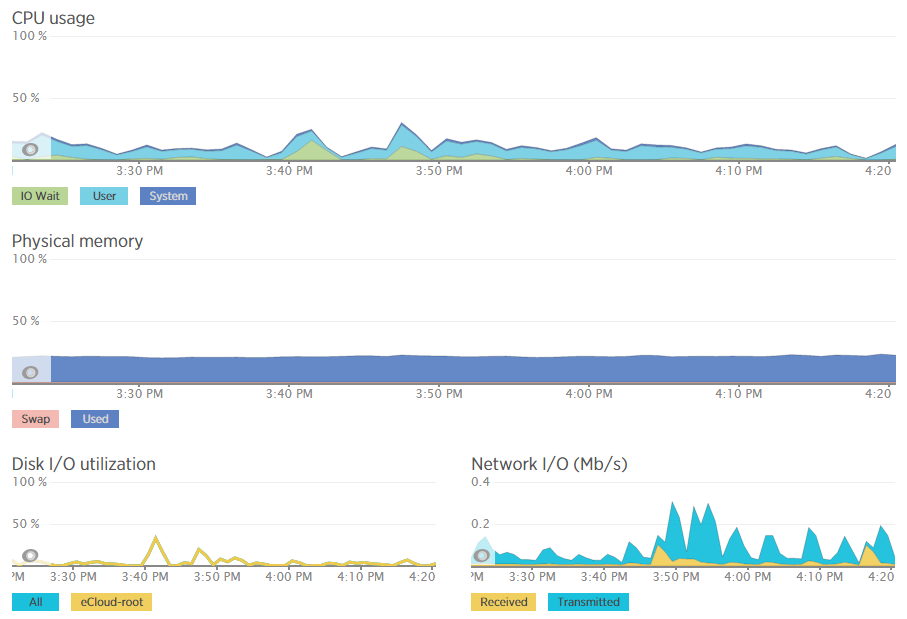
Industry Conferences and Events

Being at the forefront of digital we often get asked to speak at industry conferences and events and this year was no different. Getting involved with Salford University’s Creative Entrepreneur event at MediaCityUK to talk to businesses about the Christmas retail period and how they can take advantage of this. In addition to running many workshops of our own we’ve also been involved with organising this year’s WordCamp Manchester 2015 conference to give something back to the WordPress community.
The Big £5k PPC Give Away
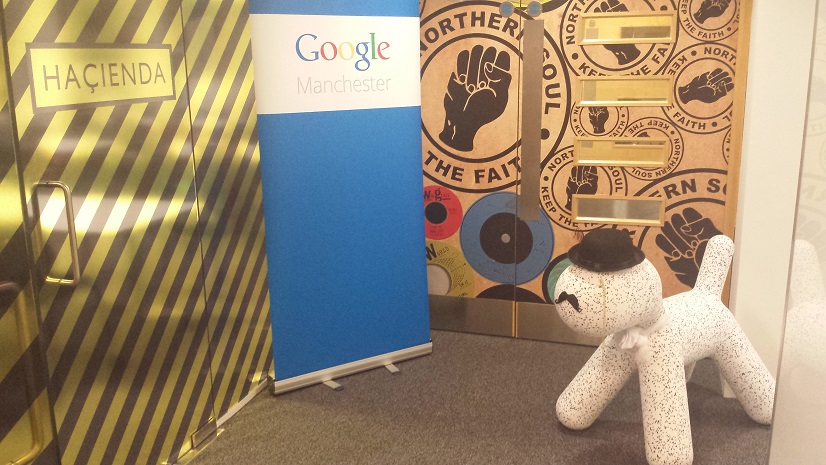
The Hacienda Lives at Google Manchester
As we’re working towards our Google Partnership status we were invited back to Google’s Manchester office for a top up course on the latest trends and techniques on Google AdWords. In addition to this, we regularly receive free Google AdWords vouchers which we give away to businesses of all sizes new to using Google AdWords. The Big £5k PPC Give Away campaign sparked a lot of interest alongside training events designed to help businesses set up their first campaign in no time.
We still have Google AdWords vouchers available, so if your business would like to take advantage of modern digital marketing, then we’ll be happy to provide a free Google AdWords voucher for you to use. Working with our dedicated Account Manager at Google, you can be sure to get the right advice that you need for your business to grow.
Google Invited us to London

As part of the Grow Local campaign, designed to get local businesses utilising Google AdWords to grow their business, Google invited us for a party in London to celebrate the achievements and the results from the campaign.
Thoughts and Discussions
Meeting regularly with business leaders, funded project partners and support agencies within the business community, we’ve been discussing some very interesting topics about how digital is shaping the world we live in. So we decided to start to write a few of these up to share our thoughts with everyone;
Rise in Problems
A bit of a downer, although worth mentioning as we’ve seen a rise in issues for businesses when it comes to the world of digital. Often related to working with inexperienced people, all of which can be avoided. Which is why we’ve started to write about the problems we’ve been seeing so businesses can learn from the mistakes of others sooner and save their business valuable time and money;
Technology Discussions
Technology allows you to implement solutions in many different ways. This in itself can cause a few issues which is why we’ve started to discuss some more technical items to help you learn from the mistakes of others;
Thinking about the right technology for your business should not be a quick decision. Speak with people and companies who are experts in their fields to ensure the technology you are implementing is going to be suitable for your needs for many years to come.
Awards & Recognition

Adding to the success of last year, we were shortlisted in the finals for the Hive Awards in three categories;
- Creative Agency Award
- International Achievement Award
- Young Entrepreneur Award
Our list of awards and recognition is growing quite nicely!
Case Studies
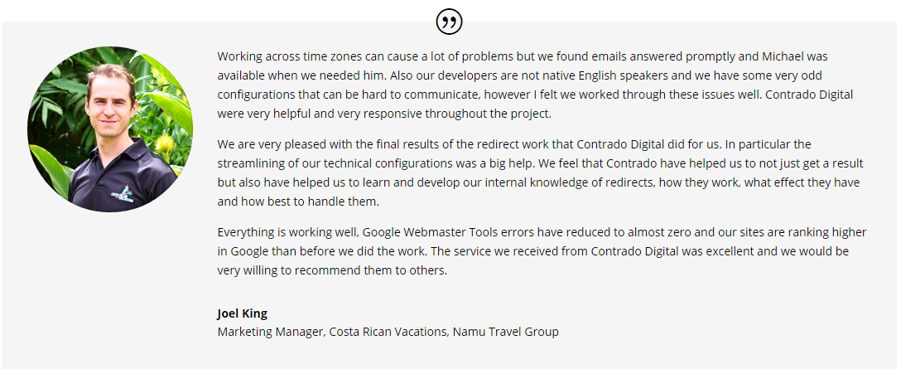
While we like to think we are rather good at what we do, it’s always nice to see such positive feedback from clients, staff and businesses who we’ve worked with recently and throughout our careers. It is comments and feedback like this which is why we do what we do. Take a look through the range of case studies and testimonials now available on the website with real feedback from real people.
Overall
Last year was an exciting time for us, really solidifying our position as the go-to company for results driven digital marketing campaigns. Anyone can build a website, ‘do SEO’ and ‘do PPC’. Very few can build a website that works, is scalable, is using the right technology and performs for SEO, PPC, Email and Social. We focus on the digital strategy for organisations looking to seriously boost their revenue online and we are being recognised for this work that we do which is fantastic to see.
Looking Ahead to the Future
So that’s just a quick summary of what we’ve been busy doing last year and what we’ve achieved in such a short space of time. Now to the future. Where are we heading next? Well, this is a really interesting and exciting time for us but we can’t go into too much detail just yet…
Alongside the regular ambitious businesses we work with, suffice to say that we’re working on some super exciting internal projects that are scheduled to launch before the end of the year. One of these specifically is something that has been in development for over 12 months which is designed to revolutionise the way people find jobs. Stay tuned for more on this as announcements are made!
Keeping in line with the regular work, we’re always on the lookout for ambitious companies to work with who need direction with their digital strategy. We’ve been working with larger businesses last year and technology start-ups which is always exciting. Whatever the size of business, as long as you’re ambitious, there is generally something we can do to help, so get in touch and lets discuss things further.
by Michael Cropper | Sep 21, 2015 | Uncategorized @en-us |
That’s right folks, it’s that time of year again, and we’ve reached the grand old age of 2!! Yay!

So at this special time of year, it’s always nice to look back at what we’ve achieved and where we are heading next.
Accomplishments
Below are some of our notable accomplishments in our 2nd year of business.
Expanded Resources

We’re committed to providing businesses with the right digital knowledge and expertise as they need it which is why we’ve significantly expanded our free Digital Resources to include guides on many of the topics that we often get asked about from businesses. If you haven’t had a look already, browse through our range of digital resources and particularly our Really Simply Guide series which explain things without the jargon;
- Block Referrer Spam in Google Analytics
- Digital Jargon Buster
- Digital Myth Buster
- Digital Pulse
- Cyber Security
- Really Simple Guide to Business Email Addresses
- Really Simple Guide to Digital Ownership
- Really Simple Guide to Search Engine Optimisation
- Really Simple Guide to Pay per Click Advertising
- Really Simple Guide to Blogging
- Really Simple Guide to Tracking Online Advertising
- Really Simple Guide to Payment Gateways
- Really Simple Guide to Email Marketing
Online Security

Online security is one of the greatest challenges to date which is why we’ve been sharing regular security related news to keep you and your businesses safe from cyber criminals. We’re on top of security so you can focus on running your business
Read through our online security resources and news and our write up of the Cyber Security Conference we attended.
We’ve Gone International

Taking the skills, knowledge and experience of Contrado Digital over to the USA. Digital channels make the world more accessible than ever before when you understand how to take advantage of these channels. Not only have we helped businesses in international markets, we’ve also gone international ourselves with a fully multi-lingual website allowing us to capture more online searchers in new markets.
Going beyond this we also provide specialised training with our Digital Passport to Export programme which has been designed specifically to look at how your business can grow internationally without the traditional costs involved.
We’ve Partnered with UKFast to Offer Industry Leading Web Hosting

Your website is more than just a few digital files sat on a web server, it is the front door to your business for the modern consumer. That’s why we’ve partnered with UKFast in Manchester to offer industry leading web hosting to businesses to ensure your website is running on the right technology that is suitable for your needs.
Beyond this we’ve invested heavily in industry leading web server resource monitoring technology allowing us to further solidify our web hosting offering for businesses with the confidence that we can significantly minimise the problems that often come with web hosting.

Industry Conferences and Events

Being at the forefront of digital we often get asked to speak at industry conferences and events and this year was no different. Getting involved with Salford University’s Creative Entrepreneur event at MediaCityUK to talk to businesses about the Christmas retail period and how they can take advantage of this. In addition to running many workshops of our own we’ve also been involved with organising this year’s WordCamp Manchester 2015 conference to give something back to the WordPress community.
The Big £5k PPC Give Away

The Hacienda Lives at Google Manchester
As we’re working towards our Google Partnership status we were invited back to Google’s Manchester office for a top up course on the latest trends and techniques on Google AdWords. In addition to this, we regularly receive free Google AdWords vouchers which we give away to businesses of all sizes new to using Google AdWords. The Big £5k PPC Give Away campaign sparked a lot of interest alongside training events designed to help businesses set up their first campaign in no time.
We still have Google AdWords vouchers available, so if your business would like to take advantage of modern digital marketing, then we’ll be happy to provide a free Google AdWords voucher for you to use. Working with our dedicated Account Manager at Google, you can be sure to get the right advice that you need for your business to grow.
Google Invited us to London

As part of the Grow Local campaign, designed to get local businesses utilising Google AdWords to grow their business, Google invited us for a party in London to celebrate the achievements and the results from the campaign.
Thoughts and Discussions
Meeting regularly with business leaders, funded project partners and support agencies within the business community, we’ve been discussing some very interesting topics about how digital is shaping the world we live in. So we decided to start to write a few of these up to share our thoughts with everyone;
Rise in Problems
A bit of a downer, although worth mentioning as we’ve seen a rise in issues for businesses when it comes to the world of digital. Often related to working with inexperienced people, all of which can be avoided. Which is why we’ve started to write about the problems we’ve been seeing so businesses can learn from the mistakes of others sooner and save their business valuable time and money;
Technology Discussions
Technology allows you to implement solutions in many different ways. This in itself can cause a few issues which is why we’ve started to discuss some more technical items to help you learn from the mistakes of others;
Thinking about the right technology for your business should not be a quick decision. Speak with people and companies who are experts in their fields to ensure the technology you are implementing is going to be suitable for your needs for many years to come.
Awards & Recognition

Adding to the success of last year, we were shortlisted in the finals for the Hive Awards in three categories;
- Creative Agency Award
- International Achievement Award
- Young Entrepreneur Award
Our list of awards and recognition is growing quite nicely!
Case Studies

While we like to think we are rather good at what we do, it’s always nice to see such positive feedback from clients, staff and businesses who we’ve worked with recently and throughout our careers. It is comments and feedback like this which is why we do what we do. Take a look through the range of case studies and testimonials now available on the website with real feedback from real people.
Overall
Last year was an exciting time for us, really solidifying our position as the go-to company for results driven digital marketing campaigns. Anyone can build a website, ‘do SEO’ and ‘do PPC’. Very few can build a website that works, is scalable, is using the right technology and performs for SEO, PPC, Email and Social. We focus on the digital strategy for organisations looking to seriously boost their revenue online and we are being recognised for this work that we do which is fantastic to see.
Looking Ahead to the Future
So that’s just a quick summary of what we’ve been busy doing last year and what we’ve achieved in such a short space of time. Now to the future. Where are we heading next? Well, this is a really interesting and exciting time for us but we can’t go into too much detail just yet…
Alongside the regular ambitious businesses we work with, suffice to say that we’re working on some super exciting internal projects that are scheduled to launch before the end of the year. One of these specifically is something that has been in development for over 12 months which is designed to revolutionise the way people find jobs. Stay tuned for more on this as announcements are made!
Keeping in line with the regular work, we’re always on the lookout for ambitious companies to work with who need direction with their digital strategy. We’ve been working with larger businesses last year and technology start-ups which is always exciting. Whatever the size of business, as long as you’re ambitious, there is generally something we can do to help, so get in touch and lets discuss things further.
by Michael Cropper | Sep 20, 2015 | SEO |
Slides from our talk at Manchester WordPress User Group in September 2015;
Additional Notes
In addition to the slides, additional comments & resources mentioned;
- Use UTM Tracking Parameters on everything
- Google has a UTM URL Builder which can be found here, https://support.google.com/analytics/answer/1033867?hl=en, but we prefer ours here, https://www.contradodigital.com/resources/social-media-tracking-tool/
- Use Event Tracking on everything that someone does on the website that isn’t a page view. This will provide awesome insights into how your website visitors are behaving. Things like social media links, clicking to download, using Yoast SEO Plugin to track outbound links once the setup is configured correctly. Likewise for any mailto: and tel: links to track when customers are using click-to-email and click-to-call technologies.
- Set up goal tracking for everything!
- Set up Goal Funnels, particularly if you are an ecommerce website
- Set up Site Search within the Google Analytics settings, for WordPress the default query string parameter is ‘s’ for search URLs. Try here, http://search.contrado.digital/utm for an example.
- The tracking pixel technology which can be used on all normal emails is Sidekick from Hubspot, really cool technology.
- Use the Network report at Audience > Technology > Network to see which companies have been looking at your website. Most importantly, seeing which companies are looking at your website along with a quick Google search for “{Company Name} Contact Details” means you never have to pay for some of the extortionate service that are available offering this data at a premium
- If your website still isn’t responsive, then compare the conversion rates for mobile visitors with non-mobile visitors. Imagine a world when mobile customers are converting at the same level as desktop visitors and you can calculate the value it brings to have your website responsive and mobile friendly.
- Track offline activities using smart redirects such as contradodigital.com/offer1 which 301 redirects to a UTM’d URL such as www.contradodigital.com/?utm_source=something&utm_medium=something-else&utm_campaign=something-else. Allowing you to track the return on your investment from a print based campaign all the way through to website traffic and ultimately sales or enquiries. All of this data will show within the Acquisition > Campaigns > All Campaigns report within Google Analytics
- Google Analytics uses Last Click Attribution by default. Understand the full conversion funnel and user journey with Assisted Conversions.
- Use Intelligence Events to set up alerts for when significant events happen within your Google Analytics data. This can help to identify problems on your website before they become an enormous issue.
- Use Real Time Data to see what is happening on your website right now. This is seriously cool for data geeks like myself.
- Use Advanced Segments to filter your Google Analytics data while you are browsing the different reports.
- Always have a Raw Data profile and Filtered Data profile within your Google Analytics setup for accurate reporting.
- Use Filtered Profiles if you want to permanently filter out the data from your Google Analytics reports. Use Advanced Segments if you only want to filter the data temporarily.
- When you are using Google AdWords, make sure you link your Google AdWords & Google Analytics accounts together to avoid your paid search traffic appearing as organic search traffic within Google Analytics.
- Referral spam is an enormous problem in Google Analytics at the minute so use these handy filters to remove future referral spam for good, https://www.contradodigital.com/resources/block-referrer-spam-google-analytics/. Generally speaking, any .htaccess or plugin based solution to referral spam doesn’t work that good as most Google Analytics spam is currently sent directly to Google Analytics and the bots never even visit your website.
- Use Virtual Page View tracking if using AJAX or redirect the user to a thank you page after they have submitted a form so you can track the full conversion funnel within the Funnel Visualisation report. This is possible within Contact Form 7 or Gravity Forms plugins for WordPress.
- Handy plugin for debugging your Google Analytics setup is Google Analytics Debugger for Google Chrome which can be found here, https://chrome.google.com/webstore/detail/google-analytics-debugger/jnkmfdileelhofjcijamephohjechhna?hl=en
- Mailchimp can cause a few problems within your Google Analytics data if you don’t set this up right. Keep an eye on this and configure the settings to suit your needs.
- When two links on a page point to the same location, use Enhanced Link Attribution to separate out which link users are clicking on. To do this, view the Property Settings within the Administration area and turn on Enhanced Link Attribution. Once this is turned on, when you view your In-Page Analytics report, you will be able to see which links people are clicking on.
With thanks to Andreas Andrews for making such meticulous notes of my ramblings J
Any questions, leave a comment or drop me an email.
by Michael Cropper | Sep 20, 2015 | Events |
Slides from our talk at Manchester WordPress User Group in September 2015;
Additional Notes
In addition to the slides, additional comments & resources mentioned;
- Use UTM Tracking Parameters on everything
- Google has a UTM URL Builder which can be found here, https://support.google.com/analytics/answer/1033867?hl=en, but we prefer ours here, https://www.contradodigital.com/resources/social-media-tracking-tool/
- Use Event Tracking on everything that someone does on the website that isn’t a page view. This will provide awesome insights into how your website visitors are behaving. Things like social media links, clicking to download, using Yoast SEO Plugin to track outbound links once the setup is configured correctly. Likewise for any mailto: and tel: links to track when customers are using click-to-email and click-to-call technologies.
- Set up goal tracking for everything!
- Set up Goal Funnels, particularly if you are an ecommerce website
- Set up Site Search within the Google Analytics settings, for WordPress the default query string parameter is ‘s’ for search URLs. Try here, http://search.contrado.digital/utm for an example.
- The tracking pixel technology which can be used on all normal emails is Sidekick from Hubspot, really cool technology.
- Use the Network report at Audience > Technology > Network to see which companies have been looking at your website. Most importantly, seeing which companies are looking at your website along with a quick Google search for “{Company Name} Contact Details” means you never have to pay for some of the extortionate service that are available offering this data at a premium
- If your website still isn’t responsive, then compare the conversion rates for mobile visitors with non-mobile visitors. Imagine a world when mobile customers are converting at the same level as desktop visitors and you can calculate the value it brings to have your website responsive and mobile friendly.
- Track offline activities using smart redirects such as contradodigital.com/offer1 which 301 redirects to a UTM’d URL such as www.contradodigital.com/?utm_source=something&utm_medium=something-else&utm_campaign=something-else. Allowing you to track the return on your investment from a print based campaign all the way through to website traffic and ultimately sales or enquiries. All of this data will show within the Acquisition > Campaigns > All Campaigns report within Google Analytics
- Google Analytics uses Last Click Attribution by default. Understand the full conversion funnel and user journey with Assisted Conversions.
- Use Intelligence Events to set up alerts for when significant events happen within your Google Analytics data. This can help to identify problems on your website before they become an enormous issue.
- Use Real Time Data to see what is happening on your website right now. This is seriously cool for data geeks like myself.
- Use Advanced Segments to filter your Google Analytics data while you are browsing the different reports.
- Always have a Raw Data profile and Filtered Data profile within your Google Analytics setup for accurate reporting.
- Use Filtered Profiles if you want to permanently filter out the data from your Google Analytics reports. Use Advanced Segments if you only want to filter the data temporarily.
- When you are using Google AdWords, make sure you link your Google AdWords & Google Analytics accounts together to avoid your paid search traffic appearing as organic search traffic within Google Analytics.
- Referral spam is an enormous problem in Google Analytics at the minute so use these handy filters to remove future referral spam for good, https://www.contradodigital.com/resources/block-referrer-spam-google-analytics/. Generally speaking, any .htaccess or plugin based solution to referral spam doesn’t work that good as most Google Analytics spam is currently sent directly to Google Analytics and the bots never even visit your website.
- Use Virtual Page View tracking if using AJAX or redirect the user to a thank you page after they have submitted a form so you can track the full conversion funnel within the Funnel Visualisation report. This is possible within Contact Form 7 or Gravity Forms plugins for WordPress.
- Handy plugin for debugging your Google Analytics setup is Google Analytics Debugger for Google Chrome which can be found here, https://chrome.google.com/webstore/detail/google-analytics-debugger/jnkmfdileelhofjcijamephohjechhna?hl=en
- Mailchimp can cause a few problems within your Google Analytics data if you don’t set this up right. Keep an eye on this and configure the settings to suit your needs.
- When two links on a page point to the same location, use Enhanced Link Attribution to separate out which link users are clicking on. To do this, view the Property Settings within the Administration area and turn on Enhanced Link Attribution. Once this is turned on, when you view your In-Page Analytics report, you will be able to see which links people are clicking on.
With thanks to Andreas Andrews for making such meticulous notes of my ramblings J
Any questions, leave a comment or drop me an email.
by Michael Cropper | Sep 19, 2015 | Data and Analytics, Developer |
To put things into perspective, let’s look at the handy tools we have on our personal computers for monitoring computer resource usage. If you’re on a PC then you can easily view the Performance data within your Task Manager and I’m sure there is something similar for you Mac users out there;

This is a very handy little tool which clearly shows you how your personal computer is performing and how things perform when you start to open new applications such as Microsoft Word or the memory eating Google Chrome browser. Here’s what happens when you kill Google Chrome after you have closed the application;

Interesting to say the least…
Anyhow, the point here is that monitoring the performance of your personal computer is relatively simple if you know where to look. Now we’re going to look at how to monitor your web server resources accurately using a suite of tools and also look at the significant differences between how different tools report on how many resources have been used and how many are free to use. The differences are what we are going to be focusing on as they are huge and can lead you to believe that you actually have more resources available than you really do.
Web Server Resources
Before we jump into monitoring your web server resources, let’s just define this. Essentially the key resources related to your web server include;
- CPU – The quantity of CPUs and their processing power in total.
- RAM – The quantity of memory currently in use and free for other things. Plus the quantity of RAM reserved for buffering and caching.
- Hard Disk Drive Space – The number of GBs of data you are using compared to the size of your disk.
- Disk I/O Utilisation – The number of input/output connections to the hard drive per minute which again has a limit
- Network I/O Utilisation – The amount of traffic on your physical network infrastructure
Behind all of these key metrics includes an enormous amount of information about the software that is running on the hardware and which processes are hogging these physical resources. This is where web server monitoring software comes in to its own as this can provide you with some extremely powerful data about how your web server is performing and most importantly, when you need to look at upgrading your web server to cope with the demands of the website or websites that are hosted on the web server.
Just as with your personal computer, web servers have a limit which needs to be managed effectively. If you tried to open 1000 Google Chrome browser tabs, your computer would probably grind to a halt as the physical hardware resources would be pushed over their limit. To the point where you would probably have to reboot your computer to resolve the problem. Your web server is no different, it’s just a little more complex, doesn’t have a physical button you can turn it on/off with (or kick!) and is sat in a huge data centre somewhere, ours are in Manchester & London.
When running a web server, it is clearly a little more important than your personal computer as this contains your website, the digital front of your business which is why it is essential to do everything physically possible to work towards a near 100% up-time. I’ll not cover today about why a 100% up-time is impossible to achieve and any guarantees of this are a flight of fancy, instead today we’re going to look at how to monitor your web server resources accurately using a suite of tools, specifically New Relic and Munin.
New Relic
We use New Relic on our web servers because it is extremely user friendly (well it is for someone of a technical nature compared to the other tools we have to work with). Being able to easily graph server resource usage to the n’th degree.

Which then further breaks this data down into the different processes that are using the resources, which websites hosted on the server are using the resources and also which user accounts are using the most resources and so on. Going beyond this, New Relic also allows us to monitor the up-time of our servers which is extremely useful for us to continually improve the performance of our servers over time;

As mentioned previously, a 100% up-time is almost impossible to achieve due to various reasons which we’ll cover in another blog post. As you can see in August and September, the server has been performing exceptionally well overall but has had a couple of blips which we’ve worked to improve performance following this. The important aspect here is that we are tracking this data which means that we are capable of acting on these insights we have to continually improve the service to our customers. We already use industry leading server technology which can always be improved further by actively monitoring performance and improving areas which need attention.
What is interesting with the New Relic data though is that the memory usage data isn’t quite as accurate as it seems on first glance which is due to the way Linux organises data at the operating system level to improve performance. By default, Linux see’s RAM as wasted space if it isn’t used so it looks to utilise the available RAM to speed up performance. This is great in theory, although can cause a few issues if not carefully managed. Accessing data from RAM is up to 1000 times faster than accessing the same data from a hard drive which is why RAM is such a powerful way to increase the performance of technologies and hence make your website load faster. It’s a shame that it’s so expensive to purchase in comparison. I guess we’ll just have to wait for the next wave of hardware innovations to break through this barrier. Specifically related to server management and New Relic, the underlying way Linux classifies available RAM compared to how New Relic reports on this data isn’t quite accurate which can be misleading.
For example, when analysing one of the blips we had recently, at either side of the troublesome time, server resources within New Relic were being reported at well below 30% usage for CPU and well below 40% usage for RAM;
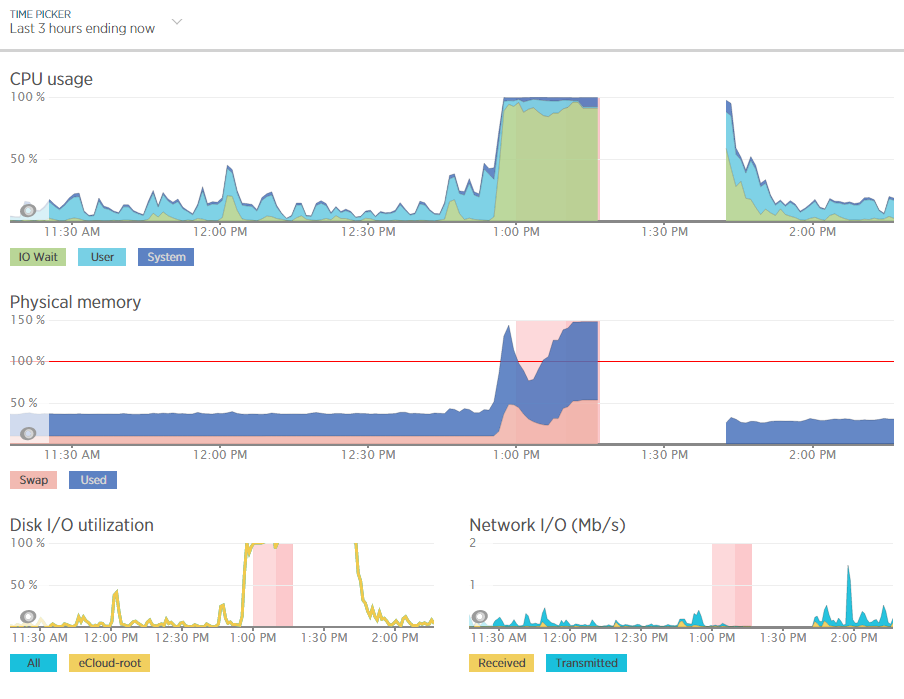
Although the blip happened for a specific reason which we needed to get to the bottom of this so we could prevent this happening again. Thankfully we have multiple tools at our disposal which allowed us to fully investigate the issue and take the necessary steps.
Using external tools is a great way of reporting on performance although they are external from the system and they may be reporting on data in a slightly different way. So we investigated this going back to the command line interface and logging into the server via SSH & PuTTY to query the server directly to get some more accurate information. What we found was rather interesting. When querying the server directly to see how much memory was being used this highlighted that the performance data within New Relic was actually quite a way off when it comes to its accuracy;

Here we see that there is only 300MB of RAM free out of 2GB opposed to the 60% free which equates to around 4x this figure at 1.2GB which is being reported in New Relic. Quite a difference here. The difference relates to the Buffer / Cache data which is being used by Linux to speed up the web server yet isn’t being taken into account by New Relic. While this is a nice setup to have, this does have its own performance issues when spikes occur which can lead to problems as outlined earlier.
Doing a one-off report for server resource usage via the command line is nice, but it is only a snapshot so doesn’t report on the true performance of the server over time. Thankfully we use another web server monitoring tool called Munin which essentially does a similar thing and much more then graphs all of this data over time.
Munin
Here is where the open source technology Munin comes in. Good old open source projects providing more insight than enterprise level software yet again. This is not a dig at New Relic as this software is really good, more of another stripe on the open source community for being so awesome.
Munin is designed to report on how your web server is performing in a similar (but not as pretty) way as New Relic. When looking at the same data within Munin as what we were looking at within New Relic the data was clear to identify what caused the issue;
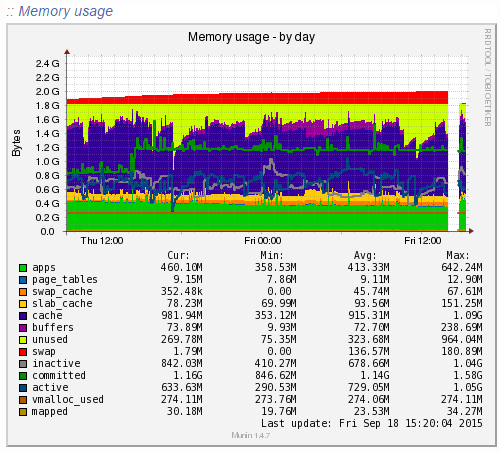
Ok, clear to me… What the above graph is showing can be summarised as;
- Red: This is the memory swap data which is outlined in more detail below. Importantly, this memory swap data is also highlighted on the New Relic graphs.
- Yellow: This is the available RAM
- Purple: This is the cached data sitting within the RAM. From New Relic’s point, this is available RAM, although from a physical hardware point, if we want to access this space we first have to clean something out, retrieve the data from the hard drive then add the data back in to RAM which consumes a large amount of processing power on the CPU
- Green: This is the memory taken from the applications in use on the web server
Note on the Red data in the graph above, the Memory Swap. What is actually happening here is that Linux is deciding what files to move in and out of memory based on what it thinks are the most important files. This work takes up valuable resources which is why the CPU levels and the Disk I/O levels on the New Relic graphs above spike right when this hits its peak. This is essentially the web server scrambling to optimise the performance at the detriment of its overall health. It’s the same as when you push yourself physically too much and then become ill from the process and need a rest. It’s the web server doing the same thing. When you start to see an increase or a significant amount of memory swap data within your New Relic graphs, I’d recommend checking to see what is really happening at the server level as this essentially highlights that your web server needs a bit more RAM or that you need to optimise the way Linux utilises the memory;

What all of this highlighted is that we needed to notch up the RAM on this server a bit. The aim was to increase the available RAM to allow for a greater amount of unused RAM meaning that the CPU nor the hard drive wouldn’t have to work as hard to access the information needed. As you can see, when we increased the RAM around 3pm in the above graph, the memory usage percentage went down within New Relic. As we know though, the New Relic data isn’t 100% accurate, so looking at the Munin data this highlights how we are now in a situation with this web server which means that the resource intensive memory swapping (the red bit on the graph) is minimal, there is more available RAM (yellow) and Linux has decided it wants to increase the cache so the websites load even faster than before;
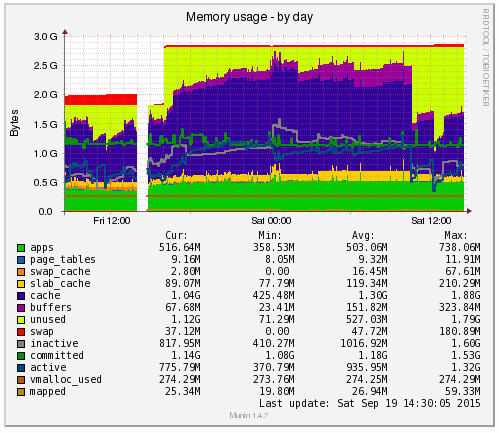
Likewise when looking at the memory usage via SSH;

This again echoes the Munin data. The above data is in kBs, showing around 1.3GB of free RAM opposed to 300MB previously.
Summary
What is extremely simple to achieve on your personal computer is a little more challenging to setup, implement and report on for your web server. Web server management is an extremely specialised field which is why we only use the best technology with a dedicated team of server engineers behind the scenes to ensure that we are continually improving the performance of our web servers. All of this is to work towards the constant goal of 100% up-time for your business websites.
Not all web hosting is the same and not all web hosting companies work in the same way. Speaking for ourselves, we take web hosting seriously. A web server is not just a computer that sits in the corner somewhere which hosts your website. A web server is the cornerstone of your digital storefront which is why we invest heavily by utilising leading technologies allowing us to continually improve our services for all our web hosting customers.
As a take away from this post. If you’re a non-technical person looking for web hosting, you can guarantee that we’re ‘on it’ when it comes to hosting. If you’re a technical person reading this, then the top tip is to use multiple web server resource monitoring packages to provide a full insight into performance as some tools aren’t as accurate as they may seem on first glance.


































